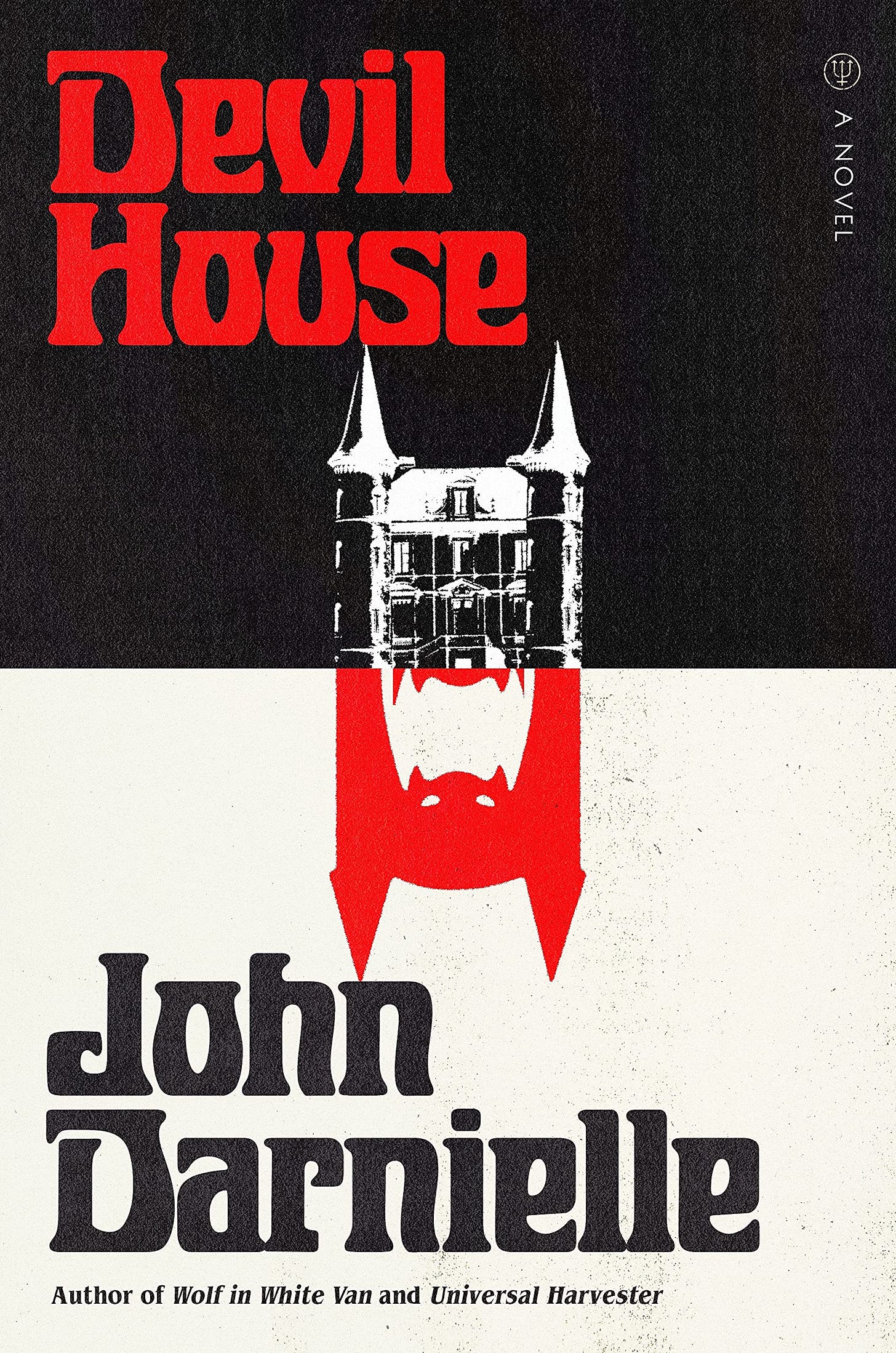“He leaned in her direction, glaring. ‘I believe in a new kind of jesus,’ he said, ‘one that can't waste his blood redeeming people with it, because he's all man and ain't got any God in him. My church is the Church Without Christ!’”
—Flannery O’Connor, Wise Blood, 1952
“Hail Satan!”
—The Mountain Goats, “The Best Ever Death Metal Band in Denton,” 2002
***
The protagonists in the opening track on The Mountain Goats’ 2002 album All Hail West Texas are childhood friends named Jeff and Cyrus who form a death metal band and practice twice a week in Jeff’s bedroom. They draw a few pentagrams and get in some sort of trouble, which leads to Jeff being sent “to the school / where they told him he’d never be famous.” They start writing letters to each other, hatching “a plan to get even.”
It’s a simple character sketch with a lot of blank spaces for the imagination to run wild, and it’s a fan favorite. At live shows, the final lines are an anthem people belt out in the aisle while swaying side by side:
When you punish a person
For dreaming his dream
Don’t expect him to thank or forgive you
The best ever death metal band out of Denton
Will in time both outpace and outlive you
Hail Satan!
Hail Satan tonight
Hail Satan!
Hail, hail
John Darnielle, the frontman and songwriter for The Mountain Goats, is a self-described Catholic. I believe him when he says the characters in his songs are “personified narrators,” not necessarily representative of him but not completely independent of his personality either.
Jeff and Cyrus are quintessential Mountain Goats characters. Across a sprawling collection of home tapes and studio albums, Darnielle has breathed life into characters who take hard drugs, wreck their homes, destroy their marriages, and declare their fealty to Satan. He wrote an album from the perspective of pagans at the moment of Christian conquest; he wrote another album where every song title was a Bible verse and the lyrics dealt with severe illness and hospitalization. He has written from the perspective of a possum and of the last dodo bird on earth. Often his characters are doomed and they know it.
In the three novels he has written to date, he succeeds in putting a little flesh on the bones of the damned. I was reading Helen Rosner’s interview with Darnielle in The New Yorker this week, looking for insights into his excellent new novel Devil House, when something clicked into place.
I realized one more reason why I love John Darnielle: He reminds me of Flannery O’Connor.
I don’t want to overstate my case here, but they are both Catholic writers with a gothic sensibility and a tendency to write about misfits. In her essay “The Fiction Writer & His Country,” O’Connor wrote this (emphasis mine):
The novelist with Christian concerns will find in modern life distortions which are repugnant to him, and his problem will be to make these appear as distortions to an audience which is used to seeing them as natural; and he may well be forced to take ever more violent means to get his vision across to this hostile audience. When you can assume that your audience holds the same beliefs you do, you can relax a little and use more normal means of talking to it; when you have to assume that it does not, then you have to make your vision apparent by shock — to the hard of hearing you shout, and for the almost-blind you draw large and startling figures.
The best-known example of a “large and startling figure” in O’Connor’s work is the Misfit from her story “A Good Man Is Hard to Find.” The Misfit is an escaped convict who comes across a family stranded on the side of the road and murders them all with the help of a small gang. The grandmother is the last to be killed, and in her final moments she sees the Misfit as if he were her own son and reaches out to touch him.
Darnielle’s genre influences and theological concerns are different. He comes across as humbly agnostic and maybe more willing to believe in the inherent goodness of people. What O’Connor frequently called her “freaks,” Darnielle might describe more gently as loners, outcasts, and wistful losers — maybe people with a “high unicorn tolerance,” in the songs where he writes about sci-fi and fantasy geekdom. His humor is not nearly as dark as O’Connor’s; in fact he’s downright earnest by comparison.
But like O’Connor, he places moments of self-transcendence and empathy at the climax of many of his stories. Here’s Darnielle in that Rosner interview:
[M]ercy is the greatest thing that humans are capable of. And that means understanding people who are ignoble, damaged, broken … Because that’s what God is. That’s what God does every day: understanding you as you. He sees you, the bad parts and the good parts, and feels the same way about you.
This is not a radical departure from 2,000 years of Christian teaching. The prayer fragment, “Forgive us our trespasses as we forgive those who trespass against us,” is also an invitation to self-forgiveness, one of the harder parts of growing up and living with yourself. A basic Christian belief is that Jesus feels the same way about you as he did about the soldiers who executed him, or the same way the grandmother felt about the Misfit at the moment she grabbed him by the shoulder before he shot her, or the same way we the listeners are led to feel about Jeff and Cyrus and their unspoken crimes in West Texas. An encounter with these characters is an invitation to practice mercy, toward others and ourselves.
***
Devil House is Darnielle’s third novel and, I think, his best one yet. The titular Devil House is a vacant adult film store in a run-down California town, where a group of teenagers not unlike Jeff and Cyrus have been squatting and installing Satanic-looking art projects all over the walls and video booths.
The narrator (the main narrator, as the perspective shifts a few times) is a successful true-crime writer named Gage Chandler who’s working on a book about the unsolved multiple murders that took place inside Devil House in the 1980s. As part of his research, he moves into the Devil House, which has been renovated so as to leave no trace.
Gage describes his meticulous process for inhabiting the space and visualizing what happened. He spends long hours lining up crime-scene Polaroids with the contours of the walls, marking the former locations of corpses and weapons with a grease pencil, and crawling across the hardwood floor trying to get a sense of the space as it once was.
In another chapter told from the perspective of Derrick, one of the boys who inhabited Devil House, Derrick describes the boys’ process of installing their arcane art in the old store:
So he sketched a devil’s head, its mouth open as though to devour; it was a version of one of the monsters from Seth’s numbers booth. Seth had littered the booths with repeating motifs—”People are idiots, they never see anything,” he’d explained—and the impulse to overdo it seemed like a good one. Sometimes you have to hit people over the head with your visions to get them to notice anything.
The phrase “Satanic panic” gets mentioned maybe twice in the entire novel and isn’t as central to the plot as you might imagine. The boys in the Devil House aren’t even convincing devil worshipers; they are just acting edgy like teenage boys do. They are doing their best to scare off outsiders and preserve a little space they can call their own as high school draws to an end and the world they knew dissolves. But the real estate market is closing in on their stronghold. Their story can’t end in anything but defeat.
This novel contains many other things: thoughtful meditations on the care that teachers provide for students, long passages of faux-Chaucerian prose, trenchant critiques of the landlord class in the early years of the Silicon Valley boom. But for today, I wanted to focus on the moments of radical empathy that act as engines for the plot.
Gage, the true-crime writer, spills a lot of ink wrestling with the ethics of his job — or maybe justifying himself ex post facto. He revisits another blockbuster case, the so-called “White Witch of Morro Bay,” and fields angry correspondence from the mother of a murdered boy who feels he didn’t do her son’s story justice. He winces at the liberties taken by a director when one of his books gets adapted into a film.
Darnielle does a remarkable job sharing Gage’s internal monologue while veiling his true feelings. Take for instance this ambivalent passage:
I try to honor the dead in my books. It’s one of the things, I hope, that sets me apart a little from my partners in true crime. When I read what others write about places where the unthinkable became real, the focus always seems off to me …
I swim against the tide on this when I can, within the limitations of my word count and the known parameters of my readership’s attention span.
Even in Gage’s own internal notes, not written for public consumption, he comes across as defensive. He is a long way off from self-empathy.
Reading the novel, I realized halfway through that Gage probably wasn’t going to blow the lid off of this cold case from the ‘80s. The thing driving the plot, I realized, was his own internal anguish over his career and artistic choices. Can Gage justify his actions to himself long enough to finish writing his book? Or can he forgive himself, and in so doing what penance might he have to make?
I’ll close with this last quote from Darnielle in the New Yorker interview:
I’m over fifty. Being over fifty is miraculous. You get just a broader view on your previous iterations of yourself, and they all look like miserable failures. But I’m told that the next errand is to have pity on them. I don’t know about that. People think you should forgive them. I don’t expect to get there, but you at least get some perspective on your motivations.
He’s standing at a high vantage point. It makes for heady moments of self-reflection. It also makes for his best art yet.
***
Devil House is available to order via the Brutal South Bookshop page, where I’ll earn a small commission if you order it.
Previously I wrote about the lo-fi qualities of The Mountain Goats’ early work and how it reminded me of the Christian worship song writer Rich Mullins. You can check that out here:
Back on my usual beat, the South Carolina legislature is working steadily to dismantle public schools and attack the rights of students and teachers. Steve Nuzum has a good Twitter thread documenting how the state Senate slipped some of House Republicans’ worst ideas into budget provisos yesterday. Please follow the teacher-led advocacy group SC for Ed and support them if you can.
Thank you for reading. Hit the subscribe button if you want to keep reading things like this every week. You can sign up for free, or you can pay $5/month to support my work and get access to some extra goodies.
Twitter // Bookshop // Bandcamp // Apple Podcasts // Spotify Podcasts





